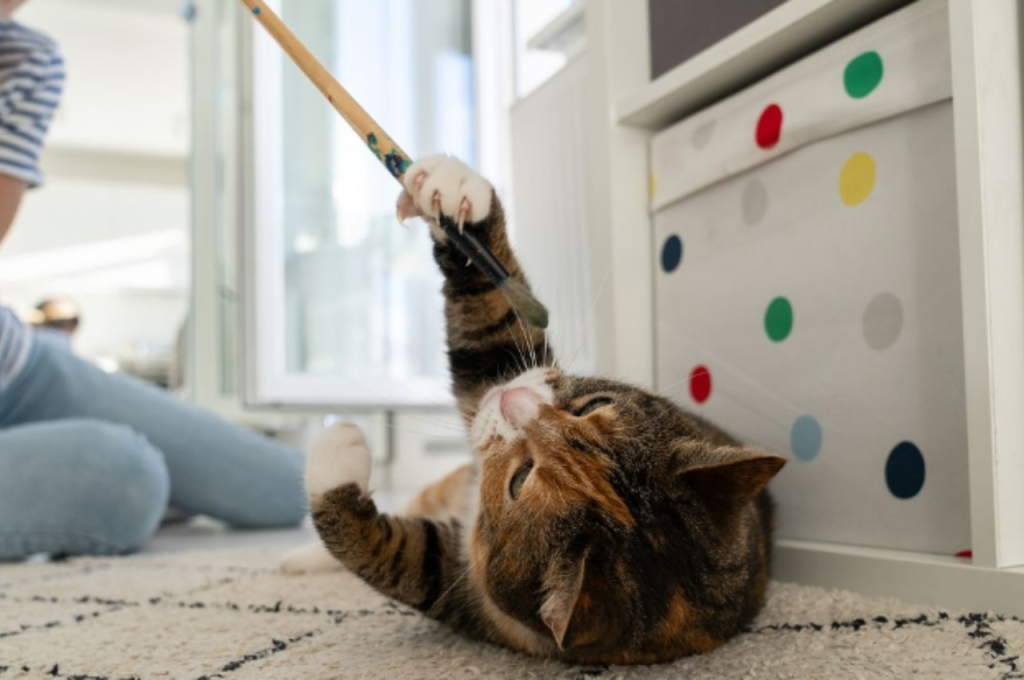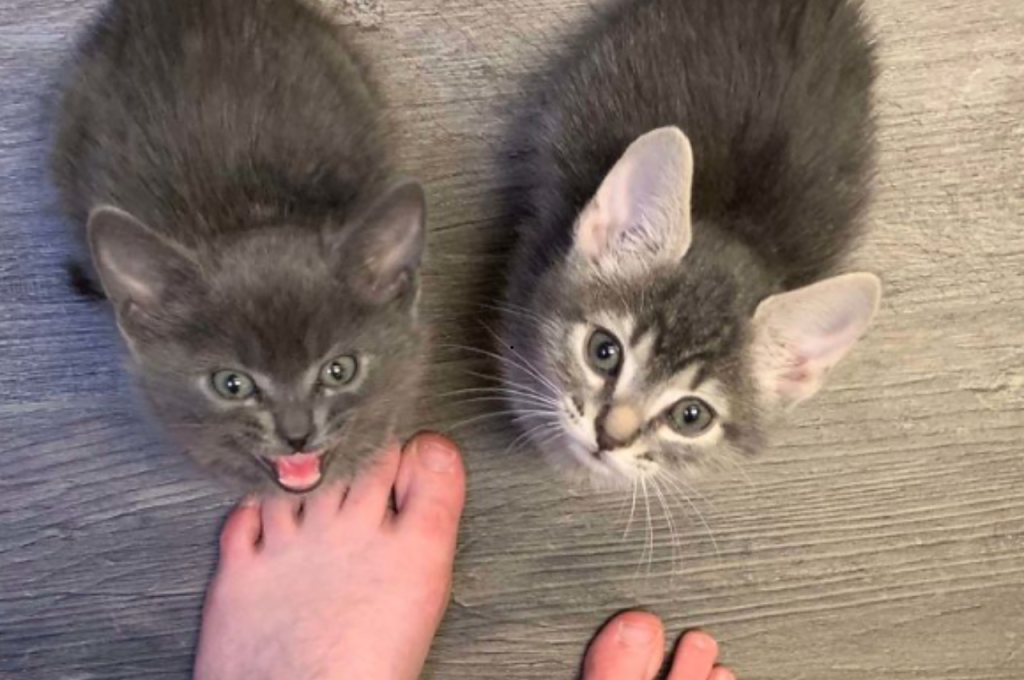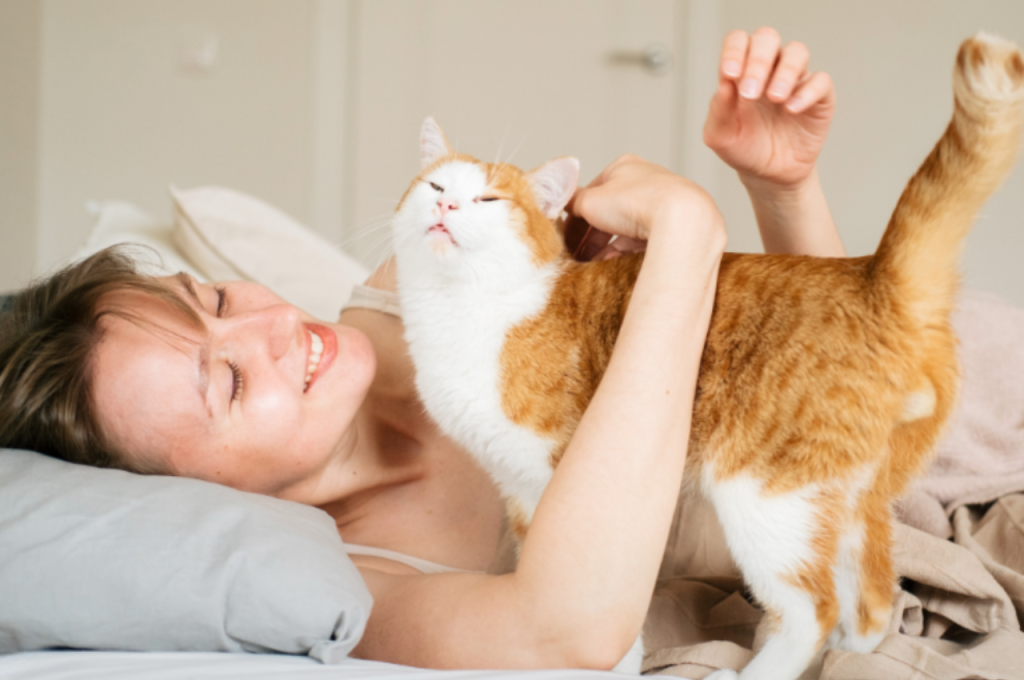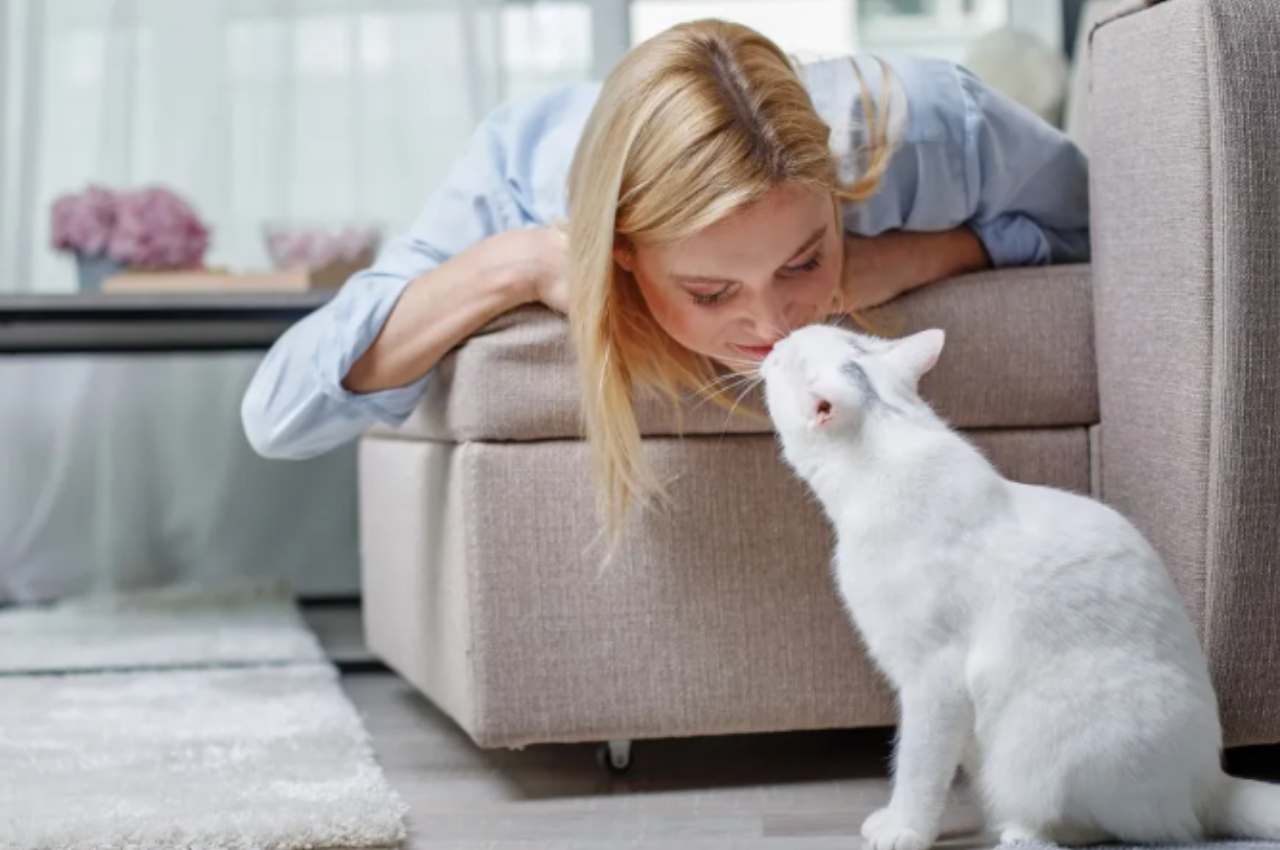You can tell if a cat trusts you by observing its body language and behavior. Signs include slow blinking, head bunting, and purring.
Building trust with a cat takes time and patience. Understanding their cues can strengthen your bond and create a loving relationship. Cats are independent creatures, so earning their trust is a rewarding experience. By paying attention to their actions and responding appropriately, you can nurture a trusting connection with your feline companion.
Introduction to Feline Trust
Curious about your cat’s trust? Watch for subtle signs like slow blinks, kneading, and exposing their belly, indicating a strong bond and trust. Pay attention to their body language for a deeper connection with your feline companion.

The Bond Between Cats and Humans
Cats are fascinating creatures, and their relationship with humans is unique. Unlike dogs, cats are independent animals who choose to interact with humans on their own terms. Building trust with a cat is essential to develop a strong bond with them. Trust is a two-way street, and it requires effort from both the cat and the human. In this article, we’ll explore how you can tell if a cat trusts you and the importance of trust in cat-human relationships.
Importance of Trust in Cat-human Relationships
Trust is crucial in any relationship, including the one between cats and humans. When a cat trusts you, they feel safe and comfortable around you. This trust allows them to relax, play, and cuddle with you. A cat that trusts you is more likely to show affection and seek attention from you. If a cat doesn’t trust you, they may hide, hiss, or scratch you when you try to approach them. It’s important to build trust with your cat to maintain a healthy and happy relationship.
Building Trust with Your Cat
Building trust with your cat takes time, patience, and understanding. Here are some tips to help you build trust with your feline friend:
- Respect their personal space
- Approach them slowly and calmly
- Avoid making sudden movements or loud noises
- Offer treats and toys
- Give them time to adjust to new situations
- Be consistent and reliable
- Provide a safe and comfortable environment
- Listen to their body language
By following these tips, you can create a positive and trusting relationship with your cat. Remember, trust takes time to build, so be patient and persistent. Once your cat trusts you, you’ll have a loyal and affectionate companion for life.
Recognizing Trust: Body Language Clues
Cat body language can reveal whether your feline friend trusts you. Look for signs such as relaxed body posture, slow blinking, and rubbing against you to gauge their level of trust. Building a bond based on trust is essential for a strong human-cat relationship.
Understanding a cat’s body language is crucial in determining if your feline friend trusts you. Cats communicate their feelings through subtle cues, and by observing their tail position, ear orientation, and eye contact, you can gain insight into their level of trust and comfort.
Tail Position and Movement
A cat’s tail can convey a wealth of information about its emotions. When a cat holds its tail upright with a slight curve at the tip, it indicates a content and trusting demeanor. On the other hand, a tail held low or tucked between the legs suggests unease or fear. A gently swaying tail is a sign of comfort and relaxation, while a rapidly twitching tail may signal agitation.
Ear Orientation and Eye Contact
A cat’s ears positioned forward indicate attentiveness and confidence, while ears flattened against the head signal fear or anxiety. Maintaining direct eye contact with a relaxed gaze can be a sign of trust, as it demonstrates a sense of security and comfort in your presence. By paying close attention to these subtle body language cues, you can better understand your cat’s level of trust and strengthen your bond with your feline companion.
The Purring Phenomenon
Cats are known for their enigmatic nature, often leaving us wondering what goes on inside their furry little heads. One fascinating aspect of feline behavior is purring. It’s a sound that brings comfort and joy to any cat lover, but have you ever wondered what it really means? In this article, we will delve into the mysterious world of purring and explore why cats purr when they do it, and what it signifies.
When and Why Cats Purr
Cats purr for various reasons, and understanding these can help you gauge their trust and comfort levels. Here are a few common instances when cats purr:
- When they are feeling content and relaxed
- During social interactions, such as being petted or cuddled
- When they are nursing their kittens
- When they are in pain or distress, as a way to self-soothe
While purring is most commonly associated with positive emotions, it’s important to note that cats can also purr when they are anxious or frightened. Therefore, it’s crucial to consider the overall body language and context to accurately interpret their purring behavior.
Purring as a Sign of Contentment
One of the main reasons cats purr is to express their contentment and relaxation. It’s their way of saying, “I feel safe and happy.” When a cat purrs, it signifies that they trust their environment and the people around them. This is especially true when they purr while being gently stroked or held.
Furthermore, purring releases endorphins, which are natural feel-good hormones. It not only helps cats relax but can also have a soothing effect on humans. So, if your furry friend curls up beside you, gently vibrating with a purr, take it as a sign of their trust and affection.
Seeking Physical Proximity
To determine if a cat trusts you, observe its seeking physical proximity. If the cat consistently approaches you, rubs against you, or curls up beside you, it is a sign that the cat feels comfortable and trusts you.
Following and Resting Near You
Cats are known for their independent nature, but when they trust you, they often seek physical proximity as a way to show their affection. One sign that your cat trusts you is if they follow you around the house or rest near you. Cats are curious creatures, so if they choose to keep an eye on your activities and stay close by, it’s a clear indication that they feel comfortable in your presence. It’s not uncommon for a trusted cat to shadow their human around the house, observing their every move.

Whether you’re cooking in the kitchen or working in your home office, your feline companion may choose to be your silent companion, following you from room to room. This behavior demonstrates their desire to be near you and their trust in your presence. Another way cats seek physical proximity is by resting near you. This can manifest in various ways, such as sitting beside you on the couch or curling up on a nearby chair while you’re working. Cats are creatures of comfort, and when they choose to relax in close proximity to you, it’s a sign that they feel secure and safe in your company.
Lap Sitting and Sleeping Preferences
Lap sitting is a clear indicator that a cat trusts you implicitly. When a cat chooses to curl up on your lap, it’s a sign of deep trust and affection. Your lap becomes their cozy sanctuary, a place where they can relax and feel content. If your cat seeks out your lap as a preferred resting spot, consider it a great compliment and a testament to the bond you share. Sleeping preferences can also reveal a cat’s level of trust. Cats are vulnerable when they sleep, so they only feel comfortable enough to doze off in the presence of someone they trust. If your cat chooses to sleep near you, whether it’s on your bed or in a nearby cat bed, it’s a sign that they feel safe and secure in your presence.
In conclusion, seeking physical proximity is a significant way for cats to show their trust in their human companions. Whether they follow you around, rest near you, sit on your lap, or sleep in your vicinity, these behaviors demonstrate their comfort and confidence in your relationship. Cherish these moments of closeness, as they signify the deep bond you’ve formed with your feline friend.
Affectionate Behaviors as Trust Indicators
Cats, known for their independent nature, often show affection through specific behaviors that indicate trust. Understanding these affectionate behaviors can provide insights into the bond you share with your feline companion.
Head Bunting and Cheek Rubs
Head bunting is when a cat gently rubs their head against you, marking you with their scent as a sign of trust. Cheek rubs are similar, showing affection and bonding.
Licking and Nibbling
Licking is a common cat behavior that signifies trust and comfort. Cats may also nibble gently, displaying their affection through grooming behaviors.
Vocalizations and Communication
As a cat owner, it is essential to know if your feline friend trusts you. One way to determine if your cat feels comfortable around you is by observing their vocalizations and communication. Cats use various sounds to express their emotions and needs, and understanding these sounds can help you build a stronger bond with your pet.
Understanding Different Meows
Meowing is the most common sound that cats make, and it can mean different things depending on the tone and pitch. A short, high-pitched meow is a greeting, while a prolonged meow indicates a demand for attention or food. A low-pitched meow, on the other hand, is a sign of discontent or discomfort. If your cat meows at you frequently and follows you around, it is a positive sign that they trust you and feel comfortable in your presence.
Chirps and Chatters: More Than Just Noises
Cats also make chirping and chattering sounds, which are different from meows and signify excitement or prey drive. Chirping is a sound that cats make when they are happy or excited, while chattering is a sound that cats make when they see birds or other prey. If your cat makes these sounds around you, it means that they are relaxed and comfortable in your presence.
Overall, paying attention to your cat’s vocalizations and communication can help you understand their emotions and build a stronger bond. If your cat meows, chirps, or chatters around you, it is a positive sign that they trust you and feel comfortable in your presence.
Exposing The Belly: a Vulnerable Gesture
Cats are known for their enigmatic behavior, often leaving their owners wondering about their true feelings. One of the most mysterious and intriguing gestures a cat can make is exposing its belly. While many people associate a cat’s belly with an invitation for a belly rub, the reality is much more complex. In fact, this vulnerable gesture can be a clear indication of the level of trust a cat has in its human companion.
Why The Belly as a Sensitive Area
The belly area of a cat is particularly sensitive due to its vital organs being located there. This vulnerability makes it a prime area for protection, especially in the wild. When a cat exposes its belly, it is showcasing a high level of vulnerability and trust.
The Trust Behind a Belly Display
When a cat displays its belly, it signifies a deep level of trust and comfort with its surroundings. By revealing this delicate area, a cat is demonstrating that it feels secure and safe in its environment, and with the people around it. This is a powerful sign of affection and trust that should not be taken lightly.
Interpreting Trust Through Play
Cats are known for their complex and enigmatic nature, making it sometimes challenging to discern their true feelings. One of the key ways to gauge a cat’s trust is by observing their behavior during playtime. Understanding how your feline friend engages in playful activities can offer valuable insights into the level of trust they have in you.
Playful Behavior and Trust Building
Playful behavior is a significant indicator of a cat’s trust. Cats often exhibit a more relaxed and open demeanor when they feel secure in their environment and with their human companions. By paying attention to the way your cat interacts during play, you can gain a better understanding of their level of comfort and trust in your presence.
Interactive Play as a Sign of Comfort
Interactive play between a cat and their owner is a clear indication of comfort and trust. When a cat actively engages in interactive play, such as chasing a toy or participating in a game of hide-and-seek, it demonstrates a strong bond and a sense of security in the relationship. This form of play allows the cat to express their natural instincts while also strengthening the bond with their human companion.
Strengthening Your Bond with Your Cat
Building trust with your feline friend can take time, but it’s worth it to have a strong and loving relationship. By understanding the signs of trust and taking the time to consistently show your cat love and patience, you can strengthen your bond and create a trusting environment for your pet.

Consistency and Patience in Building Trust
Consistency is key when it comes to building trust with your cat. This means consistently showing your pet love and care, being patient with them, and respecting their boundaries. It’s also important to consistently provide food, water, and a clean litter box to help your cat feel secure and comfortable in their environment.
Patience is also important when building trust with your cat. It’s normal for cats to be wary of new people and situations, so it’s important to give them time to adjust and feel comfortable. Avoid forcing your cat into situations they’re not comfortable with and instead allow them to approach new experiences on their own terms.
The Rewards of a Trusting Cat Relationship
The rewards of a trusting cat relationship are immeasurable. A cat that trusts you will be more affectionate, playful, and confident in your presence. They’ll also be more likely to seek out your company and enjoy spending time with you. By taking the time to build trust with your cat, you’ll create a strong and loving bond that will last a lifetime.
In conclusion, building trust with your cat takes time, patience, and consistency, but the rewards are well worth the effort. By understanding the signs of trust and taking the time to strengthen your bond, you’ll create a loving and trusting environment for your feline friend.
Conclusion
Understanding a cat’s trust is key. Observing body language signals trust. Patience and love build trust. Creating a bond takes time. Remember, trust is earned. Building trust with your cat is a rewarding experience for both of you.
